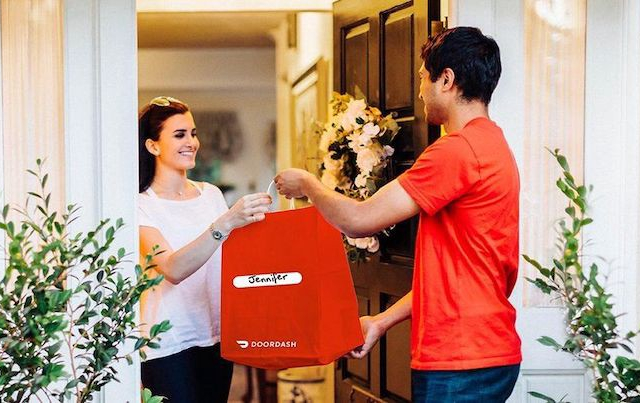At first, I thought little of the notice on one of my food news feeds, that new deep discount DoorDash deals on stuff ordered though it’s own store and selected resto partners. Then, as I read the story, an unspoken message began to emerge. Is inflation starting to hurt food delivery services?
 DoorDash Delivery to Woman – © DoorDash
DoorDash Delivery to Woman – © DoorDash
I’m waiting to see whether Door Dash is the only major food delivery sector player to mount an extended deep discount promo. Their Summer Dash Pass program offers month-long savings on a huge variety of food delivery services across the U.S. and Canada. But why?
I have a theory…
I think the food delivery services are starting to feel a pinch. And it think it’s because fewer folks are using them, or using them as much, due increased food price inflation and increases in delivery service prices over the past few months. It makes sense that the services would be facing the same effects of inflation as the rest of the greater food service industry. Increased fuel prices and other operating costs plus increased prices for the products they handle, constitute a double whammy. Delivery may be pricing itself out of reach for it’s less affluent users. And it’s not greed. It’s just economic reality.
A bigger slice of a smaller pie
It’s an old story with a new twist. As folks drop delivery services to save money on food, delivery companies must do something to grab a larger slice of the shrinking pie. Otherwise, their revenues will shrink along with the pie.
But how much can be saved? Quite a bit actually, when you look into it. Perhaps as a way to camouflage the true cost of its services, Door Dash gets coy about rates on its website, as well as under questioning by reporters. The only consistent message is that charges per order vary from $1.99 to $5.99, depending on region and food source. But there are so many exceptions, depending on the resto partner or grocer involved, that it’s virtually impossible to keep track of them all. And I couldn’t find any independent site online where some watchdog is keeping track.
A complex equation
The root of the problem is that the final premium you pay for any given food delivery depends on a combination of fees and mark-ups which can vary from order to order. Techcrunch.com has been kind enough to lay it all out for us. To begin with, at least 5 different variables go into the fee calculation equation:
- Menu item: the actual food you are ordering, or Resto List Price
- Service fee: a fee charged by the delivery company for providing the service
- Taxes: sales tax on your order based on applicable local tax laws
- Delivery fee: the price for having the food delivered
- Gratuity: This is the optional tip for the delivery driver. As such, it’s not a fee component that’s controlled by the service provider.
The Techcrunch experiment
Techcrunch took it upon itself to survey, “10 restaurants each in Los Angeles, New York and San Francisco that were available on at least four of the five [leading] apps, and selected the same menu item for delivery to the exact same address.”
What they found
Techcrunch created a new metric to define their results called Total Meal Cost (TMC). They found that, as of December 2019, that the premium customers pay for delivery over and above the Resto List Price varied from service provider to service provider by a margin of 17.0 percent to 45.5 percent.
Caveat: This survey was performed back in 2020. While the absolute numbers may have changed, the principles behind it remain the same.
My take
The DoorDash premium over and above the Resto List price was second highest among the services surveyed: 32.2 percent. In other words. A $10.00 food order would have cost $13.20 by the time it got to your door. That might not sound like a lot, but it adds up.
The Resto List Price of a Big Mac, Medium Fries and a Medium drink from McDonald’s is $8.99. Add the 32.2 percent DoorDash premium ($2.89) and it comes out to $11.99. Again, that doesn’t sound like a lot. But if you order that meal (or its price equivalent) 4 times in a week, the total premium comes out to $11.56 – almost the cost of whole additional meal! Folks who are having trouble making ends meet can’t have taken long to realize that delivery has become an unsustainable luxury.
Keep your eyes peeled for similar discounts from the other major delivery services… And don’t be too surprised if some services merge or close their doors in the coming months.
Muse on that…
~ Maggie J.

